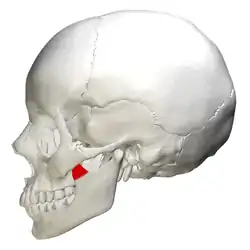Coronoid process of the mandible
In human anatomy, the mandible's coronoid process (from Greek korone, "like a crown") is a thin, triangular eminence, which is flattened from side to side and varies in shape and size. Its anterior border is convex and is continuous below with the anterior border of the ramus. Its posterior border is concave and forms the anterior boundary of the mandibular notch. The lateral surface is smooth, and affords insertion to the temporalis and masseter muscles. Its medial surface gives insertion to the temporalis, and presents a ridge which begins near the apex of the process and runs downward and forward to the inner side of the last molar tooth.
| Coronoid process of the mandible | |
|---|---|
 Position of coronoid process in skull (shown in red) | |
 Position of coronoid process in mandible (shown in red) | |
| Details | |
| Identifiers | |
| Latin | processus coronoideus mandibulae |
| TA98 | A02.1.15.032 |
| TA2 | 869 |
| FMA | 52833 |
| Anatomical terms of bone | |
Between this ridge and the anterior border is a grooved triangular area, the upper part of which gives attachment to the temporalis, the lower part to some fibers of the buccinator.
Coronoid process fractures
Mandible fractures are common injuries. However, coronoid process fractures are very rare. Isolated fractures of the coronoid process caused by direct trauma are rare, as it is anatomically protected by the complex zygomatic arch/ temporo-zygomatic bone and their associated muscles. Most fractures here are caused by strokes (contusion or penetrating injuries).[1]
Additional images
 Position of coronoid process in skull (shown in red). Animation.
Position of coronoid process in skull (shown in red). Animation. Position of coronoid process in mandible (shown in red). Animation.
Position of coronoid process in mandible (shown in red). Animation. Mandible. Outer surface. Side view. (Coronoid process labeled at top center.)
Mandible. Outer surface. Side view. (Coronoid process labeled at top center.) Medial surface.
Medial surface. The Temporalis; the zygomatic arch and Masseter have been removed.
The Temporalis; the zygomatic arch and Masseter have been removed. Coronoid process of mandible
Coronoid process of mandible Mandibular nerve and bone. Deep dissection. Anterior view.
Mandibular nerve and bone. Deep dissection. Anterior view. Infratemporal fossa. Lingual and inferior alveolar nerve. Deep dissection. Anterolateral view
Infratemporal fossa. Lingual and inferior alveolar nerve. Deep dissection. Anterolateral view
See also
References
This article incorporates text in the public domain from page 174 of the 20th edition of Gray's Anatomy (1918)
- Marius Pricop, Horațiu Urechescu, Adrian Sîrbu (Mar 2012). "Fracture of the mandibular coronoid process — case report and review of the literature". Rev. chir. oro-maxilo-fac. implantol. (in Romanian). 3 (1): 1–4. ISSN 2069-3850. 58. Retrieved 2012-08-19.CS1 maint: multiple names: authors list (link)(webpage has a translation button)
External links
| Wikimedia Commons has media related to Coronoid process of the mandible. |
- lesson1 at The Anatomy Lesson by Wesley Norman (Georgetown University)
- Anatomy photo:22:os-1006 at the SUNY Downstate Medical Center - "Osteology of the Skull: Mandible of Intact Skull"
- "Anatomy diagram: 34256.000-2". Roche Lexicon - illustrated navigator. Elsevier. Archived from the original on 2013-06-11.